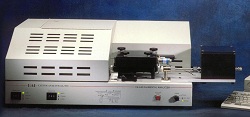A KEY factor in predicting the performance of petroleum fuels and lubricants is the percentage of carbon, hydrogen, and nitrogen (CHN) they contain. However, the volatile nature of these materials means that conventional elemental analysis is difficult to carry out.

Exeter Analytical says it has cracked the problem of CHN analysis of volatiles
CHN microanalysis of volatile compounds, particularly with high hydrogen content, requires careful handling, wide detector linearity, and easy sample residue removal.
Now Exeter Analytical has developed a new sample preparation technique which it says solves these problems, not only for volatiles but also for samples which are sensitive to exposure to the air – those that oxidise rapidly, for example – or that are hygroscopic.
The technique isolates the sample in a heavy-walled tin capsule which is cold w
elded and held under an inert atmosphere inside a laboratory glove box. This approach, together with a procedure for the introduction of the capsules into a Model 440 CHN analyser, allows these awkward samples to have their CHN fractions accurately assessed.
The method is described in Exeter Analytical’s technical report 233, available online.
